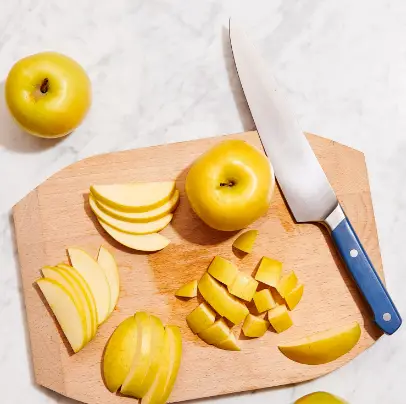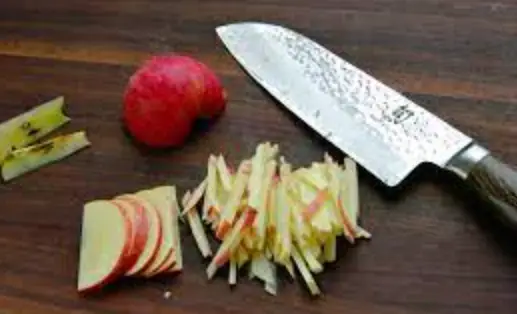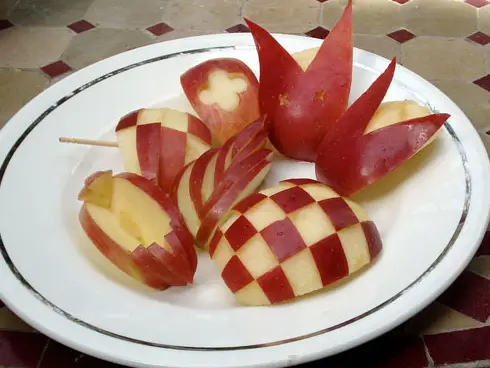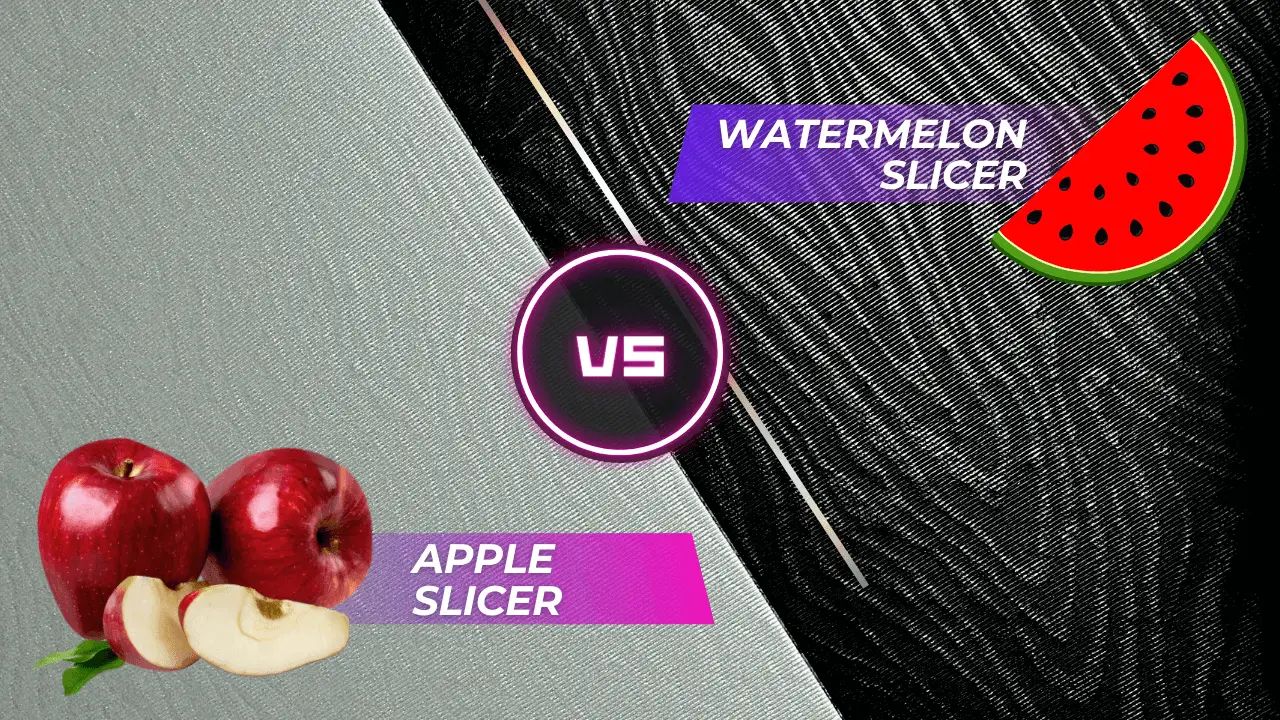Direct Answer:
When cutting an apple into different size slices, start using a sharp knife to cut half an inch to the right or left of the stem, avoiding the core. Turn the apple 90 degrees and repeat this process until you have four apple pieces and a separate core piece. The size of your slices should depend on their intended use – for example, 1/8 to 1/4 inch slices are ideal for pies, while larger slices may be better for snacks.
An apple a day keeps the doctor away. Apples are also a good source of dietary fiber and contain small amounts of Vitamin C, Vitamin A, and several B vitamins. To enjoy this nutritious fruit, slice it into various shapes and sizes to suit different culinary applications. Whether preparing a nutritious snack for your kids, a savory salad for dinner, or an apple pie for dessert, mastering the art of slicing an apple can elevate your dishes and bring out the best in this versatile fruit. With the right tools and practice, you can turn an ordinary apple into a culinary masterpiece.
The Basics: Slicing An Apple

Cutting an apple into different size slices is a skill that adds a professional touch to your culinary exploits. With a sharp knife, cut ½-inch to the right or left of the stem, cutting down, and take care to avoid the core. Turn the apple 90 degrees and make a similar cut. Repeat this process until you have four apple pieces and a core.
How Thick Should You Cut Your Apples?
Determining the thickness of your apple slices depends on your use. If you want thick, juicy slices for snacking, make them a little larger. Cut your slices between 1/8 to 1/4 inch thick for cooking purposes like apple pies. This ensures your filling cooks evenly with your crust.
Cutting Apples Into Different Shapes
Matchsticks:

Step 1: Transform your apple into matchsticks by removing the core and slicing the apple into four parts.
Step 2: Lay the apple portion cut side down and make vertical cuts to form thin slices.
Step 3: Stack these slices and make thin cuts across the stack to form the stick-shaped slices.
Dice:

Step 1: Wash and core the apple.
Step 2: Slice the apple into thick rounds, about 1/2 inch thick.
Step 3: Lay each round flat and cut it into 1/2-inch wide strips.
Step 4: Cut these strips crosswise into 1/2-inch pieces to create a dice.
Julienne:

Step 1: Wash the apple and remove the core.
Step 2: Cut the apple into thin slices about 1/8 inch thick.
Step 3: Stack these slices and cut them into thin strips, also about 1/8 inch wide.
Batonnet:

Step 1: Wash and core the apple.
Step 2: Cut the apple into 1/4-inch thick slices.
Step 3: Stack these slices and cut them into 1/4-inch wide strips.
Step 4: These strips should be approximately 2-2.5 inches long, resembling small sticks or “batons”, hence the name batonnet.
How Big Should Apple Slices Be For Apple Pie?
>The size of apple slices for an apple pie largely depends on personal preference. However, a common rule for the perfect apple pie is to cut your apple slices to about ⅛- to ¼-inch thickness. This ensures that your filling will cook at a pace similar to your crust, preventing the possibility of a beautifully baked crust with an undercooked filling. Consistency is key, so keep all your slices around the same thickness for an evenly cooked pie.
How To Cut Apple In Different Sizes Using Apple Slicer?[/su_heading]
Apple slicers usually cut apples into a fixed size, which is typically perfect for snacking or adding to a fruit salad. Follow these steps for slicing apples:
Step 1: Position your Apple: Place your apple on a sturdy cutting board with the stem facing upwards.
Step 2: Align the Slicer: Position your apple slicer so that the circular hole in the center aligns with the apple’s stem. The cutting blades should be facing down towards the apple.
Step 3: Apply Pressure: Press down on the handles of the apple slicer with steady and even pressure. The slicer will cut through the apple and separate it into uniform slices while simultaneously coring it.
Step 4: Remove the Core: After pushing the slicer completely through the apple, you’ll have uniformly sliced pieces and a separate core. Discard the core.
Step 5: Adjust Slice Thickness: If your slicer allows thickness adjustments, refer to the slicer’s manual to make the necessary changes before slicing.
Cutting Apple In Different Sizes Using Mandoline Slicer
A mandoline slicer is a fantastic tool that enables you to achieve consistent, precise cuts for your apples, especially when aiming for thin, uniform slices. Here’s a step-by-step guide to using one:
Step 1: Prepare the Apple: Wash your apple and remove the stem before slicing. You may peel the apple or leave the skin on for added texture and color depending on your preference.
Step2: Set Your Mandoline: Adjust the thickness setting on your mandoline slicer to your desired slice size. If unsure, start with a medium thickness and adjust as necessary.
Step 3: Hold the Apple: Grip the apple using the handguard with the mandoline slicer. This handguard grips the fruit and protects your fingers as you slice. Position the apple vertically against the handguard.
Step 4: Begin Slicing: Start from the top of the mandoline, gently press the apple against the blade, and slide downwards. The slicer should easily cut through the apple, giving you a perfectly thin slice.
Step 5: Continue Slicing: Repeat the above step, maintaining consistent pressure, until you’ve sliced the entire apple.
Step 6: Change the Thickness: If you desire different sizes of slices, adjust the thickness setting on your mandoline and repeat the slicing process.
FAQs
How do I prevent my apple slices from turning brown?
You can prevent apple slices from browning by soaking them in cold water and lemon juice immediately after slicing. The acid in the lemon juice helps prevent oxidation, which causes browning.
How many slices are in an apple?[/su_heading]
>The number of slices in an apple can vary significantly depending on the size of the apple and the thickness of the slices. If you’re using a standard apple slicer, which typically cuts an apple into 8 slices, you will end up with 8 slices per apple. However, if you’re slicing by hand for a specific recipe, you could have more or fewer slices.
Is cutting an apple chemical?[/su_heading]
chemical changes occur. The act of cutting the apple is a physical change as it alters the apple’s form but doesn’t change its inherent nature or create a new substance.
However, once cut, the apple undergoes a chemical change due to a process called oxidation.
What Minerals Are In An Apple?
Apples are nutritious fruits packed with a variety of essential vitamins and minerals, including:
- Potassium: This vital mineral helps balance fluids in your body and aids in muscle contractions and nerve signals.
- Calcium: While not present in large amounts, apples do contain calcium, a mineral crucial for bone health.
- Magnesium: This mineral is important for many processes in the body, including regulating muscle and nerve function, blood sugar levels, and blood pressure.
- Phosphorus: Phosphorus is essential for the formation of bones and teeth and plays a role in how the body uses carbohydrates and fats.
- Manganese: A trace mineral, manganese aids in metabolism, bone formation, and reducing inflammation.
What Are The Benefits Of Eating Apples On An Empty Stomach?
Eating an apple on an empty stomach, especially first thing in the morning, can have several potential benefits:
- Boost Digestive Health: Apples are rich in dietary fiber which can aid in digestion and help maintain bowel regularity. Consuming them on an empty stomach might give your body a kick-start in the digestion process for the day.
- Rich in Antioxidants: Apples are packed with antioxidants that fight free radicals and prevent oxidative stress. Consuming them in the morning can ensure these antioxidants are readily absorbed.
- Hydration: Apples have a high water content which can help in maintaining hydration, especially after a long night’s sleep.
- Promote Satiety: The fiber in apples slows digestion and promotes feelings of fullness, which could help you control your appetite later in the day.
- Provide Energy: Apples contain natural sugars, which are absorbed slowly and can provide a steady energy release, unlike the sudden spike and crash associated with refined sugars.
Conclusion
Slicing apples into different sizes is a skill that can significantly enhance your cooking and baking experiences. The cut can affect the texture, cooking time, and even flavor absorption of the apple in your dish. Safety should be your priority when dealing with sharp tools. Always use a properly sharpened knife for ease of cutting and to minimize potential injuries. And if you’re looking to achieve paper-thin consistency in your slices, consider investing in a mandolin slicer.
Key Points
<
- Slicing apples requires a sharp knife and a little practice.
- The thickness of your apple slices depends on their intended use.
- Slices for apple pies should be around ⅛- to ¼-inch thick.
- You can achieve several shapes, including matchsticks, dice, juliennes, bonnets, and shaved slices.
Different Apple Cuts And Their Sizes
| Cut Type | Description | Approximate Size |
|---|---|---|
| Standard Slice | These are straightforward slices cut off from the core of the apple. | ½-inch thickness |
| Matchsticks | Thin, stick-like slices that resemble matchsticks. | ⅛-inch thickness, 2-inch length |
| Large Dice | Cubes cut from crosswise slices of apple. | ¾-inch cubes |
| Small Dice | Smaller cubes are also cut from crosswise slices. | ¼-inch cubes |
| Julienne | Thin, stick-like pieces that are longer and thinner than the matchsticks. | ⅛-inch thickness, 2-3 inch length |
| Batonnet | Larger, stick-like pieces that resemble small French fries. | ½-inch thickness, 2-3 inch length |
| Shaved Slice | Paper-thin slices of apple, are usually achieved with a mandolin slicer or a very sharp knife. | Paper-thin slices |
| Pie Slice | Slices cut specifically for apple pie filling. | ⅛ to ¼-inch thickness |

John Hebdon is a food enthusiast, passionate chef, and author of various articles and blog posts related to food and cooking. With a deep love for all things culinary, John’s blog serves as a platform to share his extensive kitchen experiences with a broader audience.
In addition to his culinary expertise, John has a flair for writing and a natural ability to share his passion for food with others. His articles and blog posts are informative, engaging, and packed with practical tips for readers of all skill levels.
As a food enthusiast and writer, John is always on the lookout for new and exciting culinary experiences. Whether it’s trying out a new restaurant, experimenting with a new recipe, or simply sharing a favorite dish with friends and family, John is always eager to explore and share the world of food with others.






